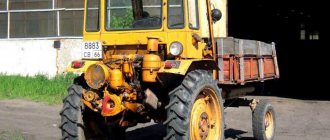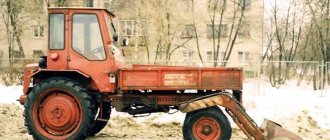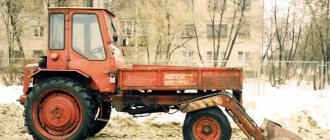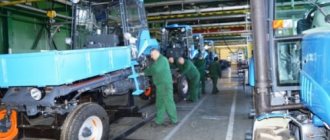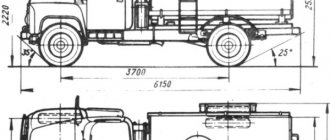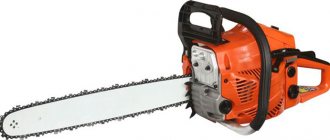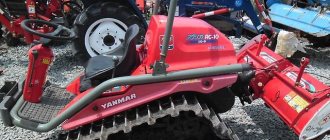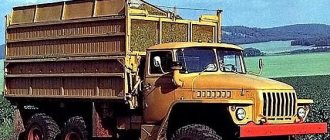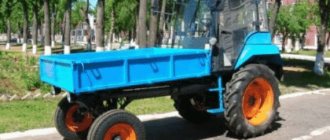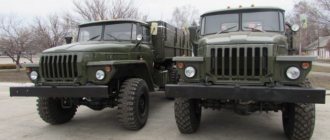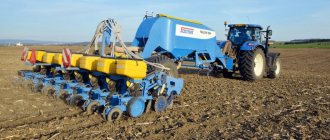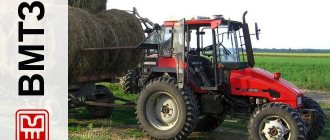Machine design
Structurally, the machine is a motorized vehicle built using tractor components. The T 16 self-propelled chassis is designed with a rear-engine design, with the driver's seat located above the power unit. A short tubular frame is attached to the engine, which serves as the basis for installing an onboard body or various specialized equipment. The photograph shows a typical T 16 chassis in actual use.
Thanks to this arrangement, the driver of the chassis has a good overview of the cultivated area and mounted units. The center of gravity of the machine is shifted to the axis of the driving rear wheels, which ensures reliable grip on the surface. To drive various auxiliary devices, the gearbox has up to three mounting points for power take-offs. A drive pulley can be used to drive stationary installations. In addition, the chassis can be equipped with a hydraulic system.
The chassis could be equipped with a dump platform, agricultural or municipal equipment, and installations for road repair and maintenance. The maximum load capacity of the chassis is up to one ton. It should be noted that the machine was originally created with an eye to use in agriculture. The chassis ground clearance increased to 56 cm allows for the processing of grape crops.
The T 16 self-propelled tractor chassis has become one of the most popular in the world - in total more than 600 thousand copies of the vehicle were produced. Due to its characteristic appearance, the chassis had common nicknames in the USSR: “Drapunets” or “Beggar”. The general view of the car is shown in the photograph.
Main technical characteristics of the VTZ-30SSh tractor
Technical parameters are presented in the table:
| Brand | Agromash-30 SSH | Unit measurements |
| Operating weight | 2440 | kg |
| Weight of cargo platform with lifting mechanism | 145 | kg |
| Number of gears forward travel reverse | 6 6 | |
| Longitudinal base | 25000 | mm |
| Chassis dimensions length width height | 4205 1630 2570 | mm |
| Track width on the front wheels on the rear wheels | 1324–1424 1314–1484 | mm |
| Overall dimensions of the cargo platform length width height | 2100 1450 365 | mm |
| Speed range | 5.39–23.86 | km/h |
| Load capacity | 1 | T |
| Ground clearance | 380 | mm |
Characteristics of VTZ tractors
Engine and components
The chassis' power unit was a four-stroke, two-cylinder, air-cooled diesel engine. The engine design implemented the principle of mixture formation in the prechamber. The prechamber was made as a separate part, pressed into the block head. The size of the prechamber was slightly more than a third of the total volume of the combustion chamber.
The main part of the engine was a cast-iron crankcase, to the front of which was attached an aluminum housing for the camshaft drive gears. The camshaft was mounted on ball bearings, which is a non-standard solution. The removable outer housing cover had a filler neck for oil and a crankcase ventilation breather. At the front of the engine there was a belt drive for the generator and fan. The drive was carried out from a pulley at the front end of the diesel crankshaft. On the opposite side of the engine there was a flywheel housing to which the electric starter was attached. The general view of the engine is shown in the photographs.
The crankcase had two holes for installing cylinders, four for valve drive rod guides, and eight for cylinder mounting studs. The cast iron cylinder had developed cooling fins. The inner surface of the cylinder was processed accordingly and served as a working surface. Each cylinder had an individual head with cooling fins. Early versions of the head could be made of cast iron. Cast iron parts in production were quickly replaced with aluminum ones. Thanks to the replacement of the material, it was possible to optimize combustion processes and improve the fuel efficiency of the engine. Each set of head and cylinder was attached to the crankcase with four studs.
The engine was cooled by an air flow from an axial fan, directed using a casing and deflectors. On the early model of the D 16 engine, the air flow was directed only by deflectors. The flow intensity could be adjusted by a special throttle valve at the entrance to the air intake. A double-piston pump for fuel supply and two oil filters - fine and coarse - were installed externally on the crankcase. The pump was standardly equipped with a speed regulator. The fuel supply is located in the tank under the driver's seat.
Engine characteristics
In the basic configuration, the VTZ-30SSH equipment is equipped with a 4-stroke two-cylinder engine running on diesel fuel. The power unit is cooled by air. The air cooling system has a positive effect on the design features of the engine and the machine itself, increasing its reliability and facilitating operation.
Tractor engine Agromash-30 SSH
The engine has the following technical parameters:
- operating power 30 l. s./22.1 kW;
- crankshaft rotation speed 2000 rpm;
- fuel consumption is 180 g per hour for each horsepower or 245 g/kW per hour.
Early versions
The KhZTSSh plant mastered the production of the first chassis model under the designation T 16 in 1961. In design, the vehicle was a significantly modernized version of the DSS 14. The first version was produced in small quantities, and in just 6 years a little more than 63 thousand vehicles were assembled. Photo of DSH 14 below (from the archive of Peter Shikhaleev, 1952).
One of the differences between the early chassis is the D 16 diesel with a power of about 16 hp. The gearbox had two power take-off shafts - the main and synchronous ones. Externally, the chassis was distinguished by the absence of a driver's cabin; there was only a light awning on removable arches.
Features of the device and operation
- The VTZ-30 SSh self-propelled chassis has a layout different from that used in its predecessor. The power plant is located in the rear, and in front of the cab there is a frame directly on which the body, attachments and front axle are mounted. Of course, it is possible to change the track width, as well as adjust the longitudinal base and even ground clearance. Please note that agricultural and industrial attachments can be attached to the frame. The basic package already includes a body with a dumping tool. The equipment is located in front of the cab, making it easy to see and operate. This arrangement provides good visibility and also allows better control of the position and degree of load of the mounted unit, since it is always in the operator’s field of vision. A hydraulic system is provided to control the mounted options. By the way, any attachment can be quickly mounted on a tractor and just as quickly dismantled. This does not require professional skills. The self-propelled tractor chassis has a reverse function, which is an important feature of this device itself. An equally characteristic detail is the color of the paint. Let us remember that the Soviet model T-16 was painted red. A more modern car, to follow the era of fashion trends, has a stylish blue color. Red specimens of VTZ-30SSH are very rare.
- The four-stroke diesel engine D-120, which has a proven two-cylinder layout, is responsible for performance. The design feature is the presence of air cooling and a double-row vertical arrangement of cylinders. This motor uses a thermodynamic cycle with an isochoric-isobaric heat supply. As practice has shown, air cooling has proven itself to be the best. It effectively prevents motor components from overheating. By the way, its operating power is 30 horsepower, and the crankshaft speed reaches 2000 rpm. Fuel consumption per 1 kW per hour is 245 grams, or 180 g/l. With. h.
- A cast iron housing is rigidly attached to the tractor frame, which combines the gearbox, transmission and final drive. This compact design made it possible to reduce the dimensions and reduce the wheelbase of the vehicle. In total, the gearbox has six forward and six reverse gears, which operate smoothly, without lag, vibration or noise. There are no delays when switching to higher or lower speeds. The maximum speed (in sixth gear) is 25 km/h in off-road conditions. In urban conditions, the tractor can reach 40 km/h. As for the braking part, the T-16's predecessor used simple belt mechanisms mounted in the differential axle shaft sleeves. The updated car with the VTZ-30SSH index is equipped with modern disc brakes, thanks to which it was possible to significantly reduce the braking distance.
- The frame structure of the tractor is reinforced with beams and side pipes, to which special strips are welded. Various attachments can be attached to these planks, differing in shape, weight and dimensions. The inside of the cast cavity of the rear beam is equipped with two partitions. Bushings, which are part of the steering mechanism, are pressed into the opening of the partitions. In addition, inside the rear beam there is a container for filling the hydraulic system with oil. Brackets are welded to the frame (to its left pipe), with the help of which the hydraulic distributor is held. The battery racks are also fixed in this place. The front and rear wheels can be rearranged, thereby changing the track width. As practice shows, owners can easily install a front drive axle and a winch on the tractor to increase cross-country ability. The power take-off box is independent, with speeds up to 540 rpm.
- The tractor received a rigid frame cabin, protected from damage (deformation) in the event of a rollover. Thanks to this, the operator is safe, even if the tractor overturns. The cabin is a single-seater, two-door, with simplified entry (thanks to steps and a wide doorway). Please note that the interior space of the VTZ-30SSH tractor fully meets European requirements in accordance with EU standard 79/622. This feature allows the machine to be supplied to most European countries. The cabin has its own heater and standard ventilation, which can be replaced with full air conditioning. Ventilation deflectors blow air across the front and rear windows, as well as the area in the footwells. The presence of additional external and internal lighting had a beneficial effect on visibility and visibility at night. In addition, there is a wide glass area to improve visibility, and the windshield wipers have a windshield washer. Of course, there are also rear-view mirrors, as befits modern technology. The controls are located very well, and you don’t have to reach for them - they are ergonomically grouped on the side panels.
First modernization
One of the main disadvantages of the early version of the self-propelled chassis was the insufficient engine power. Therefore, in 1967, the car was modernized by installing a 25-horsepower diesel engine. Due to this, it was possible to increase the maximum speed of the vehicle and improve cross-country ability. The new model could be equipped with a closed cabin with two doors. The roof of the cabin was made of canvas.
The modernized version of the chassis was designated T 16M and remained on the production line until 1995. During this time, the plant assembled 470 thousand copies of the car. General view of the T 16M chassis in the photo.
Second modernization
In the mid-80s, the chassis received an all-metal driver's cabin and a new D 21A diesel engine with a power of 25 hp. A comprehensive modification of the machine components was carried out, which made it possible to increase the service life and reduce the labor intensity of maintenance. It was on this model that three power take-off shafts were introduced on the gearbox. This version was designated T 16MG and was produced in parallel with the T 16M until 1995. The photo shows a typical T 16MG.
The new car had much better data. A more flexible diesel engine made it possible to reduce the minimum speed of the car to 1.6 km/h using a lower gear. Thanks to this, the chassis has become popular for road and agricultural work. On the T 16M, the ability to tip the body was introduced, driven by a hydraulic cylinder.
Transmission and steering features
Manufacturers managed to achieve compact dimensions and rigidity of the frame by placing the transmission together with the gearbox in a cast iron housing. VTZ-30SSh has 6 speeds when moving forward and backward. The ability to lock the differential can significantly improve the maneuverability of the vehicle.
Agromash-30 SSh at work
The tractor is capable of moving at a speed of 5–25 km per hour. But on a flat asphalt road the speed can be increased to 40 km per hour. True, excessive load on the engine can adversely affect its condition.
Gear shifting is carried out using a double-disc friction clutch that does not require lubrication. The power take-off shaft drive is equipped with a separate disc.
Stopping the equipment is ensured by modern disc brakes, which replaced the band brakes installed on the previous model of the self-propelled chassis. The operation of the tractor is simplified due to hydrostatic steering.
High power chassis
In the 60s, the head design bureau for combines and self-propelled chassis created several machine designs using components from more powerful tractors. The chassis was intended for the installation of various combine superstructures.
One of these products was the SSh 75 “Taganrozhets” unit, the production of which began in 1965 at the Taganrog plant. Structurally, the machine was a frame on wheels, on which the engine, transmission components, cabin and hydraulic drives became. The SSh 75 was equipped with a four-cylinder 75-horsepower SMD 14B diesel engine with liquid cooling. One of the surviving Taganrozhets is shown in the photograph.
The production of agricultural self-propelled chassis continued until the early 70s; in total, almost 21 thousand vehicles were produced. Various attachments for completing machines were produced at the same plant. Depending on the type of hitch, the cabin could stand at different points on the chassis. Mounting points were centrally above the front axle or to the side above either drive wheel. For example, when installing the NK 4 combine harvester, the cabin stood on the side, and when installing the NS 4 dump body, it was in the center, above the steered wheels.
Modern options
Currently, the tractor plant in Vladimir produces the VTZ 30SSh chassis - a universal vehicle for performing special work in various fields of the economy. Upon request, the machine can be equipped with various equipment to expand the range of applications. Thanks to the high ground clearance, the chassis overcomes water obstacles with a depth of up to 0.5 meters.
The car first appeared in 1998. The chassis design is based on the 2032 tractor and is very similar to the T 16 chassis. The difference between the VTZ 30SSh is the rear location of the engine and transmission. To increase driver comfort, the cabin has a ventilation and heating system. The flat front and rear windows are equipped with windshield wipers. As standard, the chassis comes with a steel side platform with a length of 2.1 m and a width of almost 1.45 m. The platform has low sides and can accommodate up to 1000 kg of various cargo. Vladimir chassis in the photo below.
The power unit is a 30-horsepower diesel engine D 120, which is a modernized version of the D 21A. The gearbox has six speeds and reverse capability. The speed range is from 5.4 to 24 km/h. The box has only one independent power take-off shaft.
Scope of application and modification of the self-propelled chassis "VTZ-30SSh"
Like its predecessor, the T-16, the VTZ-30SSh self-propelled chassis has a fairly long frame, which allows the use of a wide range of special devices and tools. Everyone knows the capabilities of this equipment when using it as a self-loader and simply for transporting various cargoes.
The VTZ-30SSH-SP self-loader has the following technical characteristics:
- Bucket working width – 1800 mm;
- Loading capacity of the bucket – no more than 500 kg;
- Bucket capacity – 0.4 cubic meters;
- The lifting height of the bucket is 2900 mm.
Self-loader "VTZ-30SSh".
In addition, the most suitable areas of application for VTZ-30SSh are:
- On maintenance of greenhouses, livestock farms, including inside these premises.
- When working with sprayers, pollinators, fertilizer applicators;
- When harvesting with mounted vegetable harvesters;
- Not only on vegetable, but also on tea, tobacco, and berry plantations;
- When working with forest planting machines (in forestry).
In public utilities and road repair services, "VTZ-30SSh" will be useful as:
- Sidewalk and snow removal machines;
- Road marking machines;
- Repair machines with a compressor for pneumatic tools;
- Ensuring the operation of welding units.
In warehouse and logistics complexes such as: forklifts; lifts; delivery vehicles.
Based on the VTZ-30SSh self-propelled chassis, modifications of special equipment such as forklifts, self-unloading chassis, vacuum sidewalk cleaning machines, etc. have been developed and produced.
The full list of relevant additional attachments is as follows: self-loading chassis; hydraulic front loader; cleaning brush and front-mounted brush-scraper equipment; forklift; blade with rubber knife; plow and scoop equipment; high pressure equipment for spraying and pollination; distributors of liquid and bulk reagents; combined harvesting machine; snow plow milling rotary; pumping installation for pumping out water; repair shop universal mobile; equipment for applying road markings; excavator; segment mower.
"VTZ-30SSh" on snow removal.
As additional equipment, the manufacturer offers the following options: fuel filter “Separ-2000”, independent air heater “AirTronic”, engine and cabin pre-heater “Hydronic”, fuel consumption monitoring system FMS. And also: air conditioning (yes, on top!); insulating cover.
At the request of the customer, the self-propelled chassis "VTZ-30SSh" can be specially additionally adapted as a machine for preparing a road for laying asphalt, as well as a special tea or cotton harvesting tractor.
